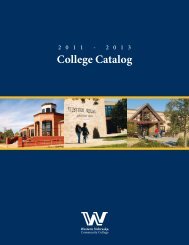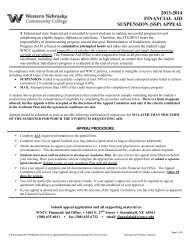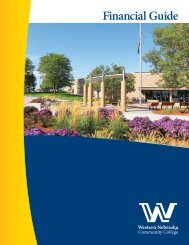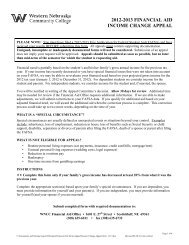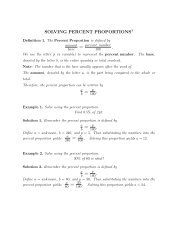WNCC 2010 Self-Study Report - Western Nebraska Community ...
WNCC 2010 Self-Study Report - Western Nebraska Community ...
WNCC 2010 Self-Study Report - Western Nebraska Community ...
You also want an ePaper? Increase the reach of your titles
YUMPU automatically turns print PDFs into web optimized ePapers that Google loves.
As depicted below (based on degree-seeking students), there are typically more females than<br />
males enrolled at <strong>WNCC</strong>, which is consistent with national trends.<br />
Table 6-26 Students by Gender 2005-2008<br />
Status Fall 2005 Fall 2006 Fall 2007 Fall 2008<br />
Male FT 357 402 406 442<br />
Male PT 560 348 581 969<br />
Total Males 917 750 987 1411<br />
Female FT 515 501 543 542<br />
Female PT 790 677 777 1017<br />
Total Females 1305 1178 1320 1559<br />
Enrollment by Campus Location<br />
The Scottsbluff campus has the greatest number of students enrolled in classes at <strong>WNCC</strong>. Based<br />
on the fall end-of-semester reports, charts are provided for enrollment breakdown by site location.<br />
Table 6-27 Enrollments by Campus Location<br />
Enrollment Fall 2004 Fall 2005 Fall 2006 Fall 2007 Fall 2008<br />
Alliance 310 220 245 205 244<br />
Scottsbluff 1355 1323 1279 1340 1271<br />
Sidney 265 228 210 243 242<br />
Projections released by the Department of Education predict that the number of high school<br />
students will continue to decline in this area, meaning that, as discussed in the earlier Responses<br />
section, two factors are critical to maintaining enrollments:<br />
1. A higher saturation rate of the available pool in an increasingly competitive environment<br />
2. Increased enrollment garnered from other populations such as second-career (or<br />
furloughed) workforce training, international, and out-of-area student enrollment, as well<br />
as senior citizens taking avocational coursework, life-long learners participating in a<br />
culture of inquiry who pursue education as a function of their personal lives, or business<br />
and industry training keyed specifically to incumbent employee skills enhancement.<br />
Although <strong>WNCC</strong> has grown consistently, except after a slight decline following an enrollment spike<br />
in 2002, the targeted numbers for growth are extraordinarily hard to define. Factors such as the<br />
national and regional economy show strong correlations to enrollment, and local economic<br />
development efforts have a significant impact upon job potentials.<br />
Regionally, the <strong>Nebraska</strong> Population Projections show declines in most counties within <strong>WNCC</strong>’s<br />
district, some as high as a 10.9% loss in Sioux County (directly north of Scotts Bluff County),<br />
varying to a 5 or 6% projected total population decline. Only Scotts Bluff (+10.3%), Morrill (+ 3%),<br />
Dawes (+ 1%), and Cheyenne (+ 4.8%) counties are expected to show population growth.<br />
Unfortunately, the counties bordering Scotts Bluff County are expected to shrink in population,<br />
although Cheyenne County, where the Sidney campus is located, will likely grow (RR 52).<br />
<strong>Western</strong> <strong>Nebraska</strong> <strong>Community</strong> College Page 85




